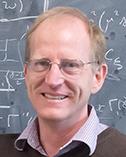
Lance Dixon
SLAC National Accelerator Laboratory
|
Primary Section: 13, Physics Membership Type:
Member
(elected 2022)
|
Biosketch
Lance Dixon is a theoretical physicist recognized for his work on quantum-mechanical amplitudes for the scattering of elementary particles, ranging from quarks and gluons in quantum chromodynamics to gravitons in theories of quantum gravity. He pioneered the unitarity and bootstrap methods for computing high-order perturbative corrections to scattering processes, which lead to precise predictions for reactions at high-energy particle colliders and provide insights into quantum field theory. Dixon was born in Pasadena, California and grew up in Manhattan Beach, California. He graduated from the California Institute of Technology with a degree in physics and applied mathematics, followed by a Ph.D. in physics from Princeton University in 1986. He held a postdoctoral position at the Stanford Linear Accelerator Center for one year before returning to Princeton as an assistant professor. In 1988, he returned to SLAC, where he was a Panofsky Fellow before joining the faculty in 1992. He was awarded the Sakurai Prize of the American Physical Society in 2014 for his scattering amplitudes research. He is a member of the National Academy of Sciences.
Research Interests
Lance Dixon is interested in the fundamental nature of elementary particle scattering. He and his collaborators and students are using methods based on unitarity to explore the hidden symmetries and properties of quantum scattering amplitudes. These methods have led to more precise theoretical predictions for high-energy particle collisions, as well as a deeper understanding of the gauge theories that underlie the Standard Model of particle physics. The quantum properties of Einstein's general theory of relativity, and supersymmetric extensions of it, can be revealed as well, by thought experiments that scatter gravitons, the quanta of gravitational waves. A maximally supersymmetric cousin of quantum chromodynamics, called planar N=4 super-Yang-Mills theory, has particularly striking symmetries, allowing some of its scattering amplitudes to be computed by a bootstrap method through seventh order in a perturbative expansion. The results expose simple all-orders behavior in a number of kinematic regions, and an intriguing new duality between scattering amplitudes and operator form factors.

